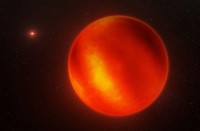
REUTERS — NASA’S Juno spacecraft sent its first in-orbit view of Jupiter after it capped a five-year journey to the planet on July 4 with a do-or-die engine burn that looped it into orbit to probe the origins of the biggest planet in the solar system and how it impacted the rise of life on Earth, the U.S. space agency said.
Juno’s visible-light camera was turned on six days after Juno fired its main engine and placed itself into Jupiter’s orbit.
The new view was obtained on July 10, 2016, at 10:30 a.m. PDT (1:30 p.m. EDT, 5:30 UTC), when the spacecraft was 2.7 million miles (4.3 million kilometers) from Jupiter on the outbound leg of its initial 53.5-day capture orbit, NASA said.
The color image shows atmospheric features on Jupiter, including the Great Red Spot, and three of the massive planet’s four largest moons – Io, Europa and Ganymede.
The first high-resolution images of the gas giant Jupiter are still a few weeks away.
Launched from Florida nearly five years ago, Juno needed to be precisely positioned, ignite its main engine at exactly the right time and keep it firing for 35 minutes to become only the second spacecraft to orbit Jupiter.
If anything went even slightly awry, Juno would have sailed helplessly past Jupiter, unable to complete a $1 billion mission.
Once in position to begin its 20-month science mission, Juno will fly in egg-shaped orbits, each one lasting 14 days, to peer through the planet’s thick clouds, map its gargantuan magnetic field and probe through the crushing atmosphere for evidence of a dense inner core.
The probe also will hunt for water in Jupiter’s thick atmosphere, a key yardstick for figuring out how far away from the sun the gas giant formed.
Jupiter’s origins, in turn, affected the development and position of the rest of the planets, including Earth and its fortuitous location conducive to the evolution of life.








